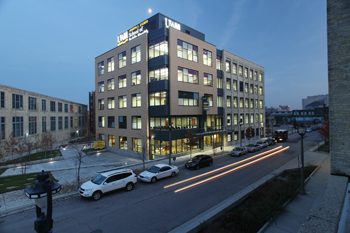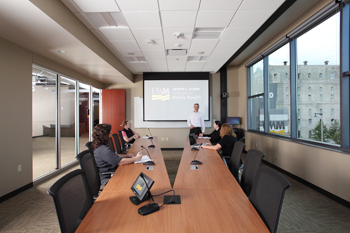Historic Building Renovation Brings College Campus to the Community
Green Construction Stats
- Reuse of over 75 percent of the existing building structure
- Recycled content included in 30 percent of materials
- 30 percent of materials purchased from local sources
- Over 95 percent of construction waste diverted from landfill
 MILWAUKEE — The University of Wisconsin-Milwaukee (UWM) recently received LEED Gold certification for its new Zilber School of Public Health. The structure is located off-campus and serves as the home for a new department at the university, which will provide all new programming and degrees to prepare students for work in the public health sector. The new department houses functions on the traditional campus and in this new satellite building, but the core of the program, including administration and the founding dean, will be located at the new site. The creation of this school of public health fits into a larger plan by the university that will bring it into the community instead of being isolated on-campus. Plans are also moving forward on off-campus buildings for a new School of Freshwater Science and an Institute for Innovation, which will expand the University’s presence to two other sections of the city. UWM already has several off-campus residence halls.
MILWAUKEE — The University of Wisconsin-Milwaukee (UWM) recently received LEED Gold certification for its new Zilber School of Public Health. The structure is located off-campus and serves as the home for a new department at the university, which will provide all new programming and degrees to prepare students for work in the public health sector. The new department houses functions on the traditional campus and in this new satellite building, but the core of the program, including administration and the founding dean, will be located at the new site. The creation of this school of public health fits into a larger plan by the university that will bring it into the community instead of being isolated on-campus. Plans are also moving forward on off-campus buildings for a new School of Freshwater Science and an Institute for Innovation, which will expand the University’s presence to two other sections of the city. UWM already has several off-campus residence halls.
The $10.5 million project was made possible by a donation from the late Joseph Zilber, a second-generation Russian-American philanthropist who grew up in Milwaukee, founded a local real estate company, Zilber Limited, and gave millions of dollars to local causes over the years.
This project involved renovating and expanding a historic building originally constructed in 1918, which used to serve as a tank house for the Pabst Brewing Company. Zilber Limited purchased the historical Pabst brewing complex in 2006 to create what Zilber called his “legacy to Milwaukee.” K&M Development, a Milwaukee-based subsidiary of Zilber Limited, served as the construction manager on the project, under a CM at-risk agreement. The project was designed by local Milwaukee firm Eppstein Uhen: Architects.
Tom Stacey, project manager for Eppstein Uhen, explained Zilber chose to make his donation for a public health school because his late wife Vera “gave up her career in nursing to support him and his career, so it was his way of giving back.”
The original structure covered 32,000 square feet and was built as a hosiery factory before being converted to a tank room when Pabst purchased it. Stacey explained the structure was hollowed out for and lined with cork on the inside to create the optimal environment for beer making. The process of applying the cork scoured the brick interior, meaning it wouldn’t be possible to leave the original brick exposed, much to the chagrin of Stacey and his team, who operate out of a brick building with an exposed interior. Instead, the interior of the building was fully insulated, the roof was replaced and mechanical systems were added, as the old structure had none whatsoever.
“From a thermal envelope perspective, it’s essentially a new building,” Stacey said.
Stacey explained new elevators and most of the equipment related to mechanical systems were installed in the new building “so as not to disrupt or potentially compromise the existing structure.”
 The historic building featured an abundance of large beautiful windows, which were bricked up by Pabst for the optimal operation of the building, meaning the panes had to be replaced. The new structure mimics that design with slightly larger windows in a similar pattern. Despite the large amount of natural light and beautiful external views, the project didn’t earn LEED points in either of those categories because the old building had lowered roofs, meaning the window sills were 54 inches high, which exceeds the LEED limit of 42 inches.
The historic building featured an abundance of large beautiful windows, which were bricked up by Pabst for the optimal operation of the building, meaning the panes had to be replaced. The new structure mimics that design with slightly larger windows in a similar pattern. Despite the large amount of natural light and beautiful external views, the project didn’t earn LEED points in either of those categories because the old building had lowered roofs, meaning the window sills were 54 inches high, which exceeds the LEED limit of 42 inches.
Stacey said he was happy the students and faculty were enjoying these features and explained he understood that the certification system was a work in process and “maybe LEED has a little bit of work to do on that one.”
The project manager explained another green highlight of the facility is the HVAC system, which features high-efficiency boilers and energy management systems. “Nothing on the innovation side with that but really solid and smart mechanical and electrical systems,” he commented.
The result of the superior building envelope and mechanical systems is a building that’s 24 percent more energy efficient than a standard structure. The building is also part of one of the first LEED Platinum Neighborhood Developments, meaning it received high scores in almost all the site-based categories like density, connectivity, and stormwater management.
The mechanical systems are stored in a small penthouse box on top of the expansion, which is cleverly disguised as signage for the new school.
“That signage is viewed by something in the neighborhood of 90,000 cars per day,” Stacey happily proclaimed.
The design team was able to maintain a lot of the charm of the historic structure. Stacey was particularly proud of a conference room that left many of the original features exposed.
“It’s a really terrific space. It’s on the fifth floor, you can see the old steel truss work for the roof and the latticed steel columns and the terracotta tile roof materials.”
Part of the strategy behind placing the building in the historic downtown complex, was to locate public health outreach services in an area that has the highest infant mortality rate and other red flags of an underserved population.
The new department and structure will provide a more direct connection with the community, as conference rooms will be available to local groups and some members of the Milwaukee Health Department will also be housed on site. Some faculty members will be dual purpose, working for the school and health department concurrently. A demonstration kitchen will provide a space for educators and health department staff to offer classes for community members on healthy cooking.
Stacey concluded that he was happy to be part of a project that brought services and the campus into the community and to participate in the college’s effort to integrate itself more with the city.
“I can’t say enough about the cooperation of faculty, the leadership of UWM, the Zilber family foundation, everyone just went to the next level to make this possible.”
